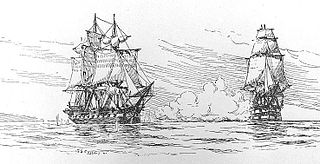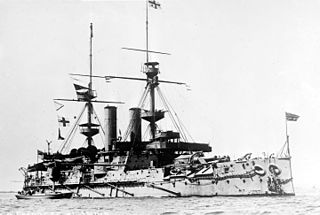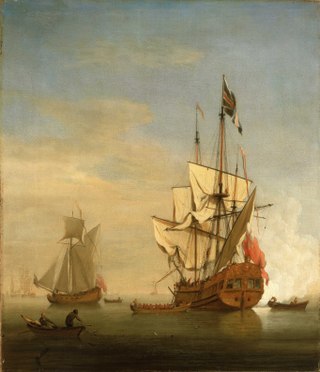
HMS Africa was a 64-gun third-rate ship of the line of the Royal Navy, launched by William Barnard at Barnard's Thames Yard in Deptford on 11 April 1781.

HMS Leopard was a 50-gun Portland-class fourth rate of the Royal Navy. She served during the French Revolutionary and Napoleonic Wars, and was notable for the actions of her captain in 1807, which were emblematic of the tensions that later erupted in the War of 1812 between Britain and America. She was wrecked in 1814.

HMS Repulse was one of seven Royal Sovereign-class pre-dreadnought battleships built for the Royal Navy in the 1890s. Assigned to the Channel Fleet, where she often served as a flagship, after commissioning in 1894, the ship participated in a series of annual manoeuvres, and the Queen Victoria's Diamond Jubilee Fleet Review during the rest of the decade. Repulse was transferred to the Mediterranean Fleet in 1902 and remained there until December 1903, when she returned home for an extensive refit. After its completion in 1905, Repulse was assigned to the Reserve Fleet until she was sold for scrap in 1911.

HMS Inconstant was an unarmored, iron-hulled, screw frigate built for the Royal Navy in the late 1860s. Upon completion in 1869, she was the fastest warship in the world and was assigned to the Channel Squadron. Two years later the ship was transferred to the Detached Squadron for a brief time before she was paid off into reserve in 1872. Inconstant was recommissioned in 1880 for service with the Flying Squadron that circumnavigated the world in 1880–82. On the return voyage, the ship was diverted to Egypt during the Anglo-Egyptian War of 1882 and played a minor role supporting operations ashore. She was reduced to reserve again after her return and was served as an accommodation ship in 1897. Inconstant was hulked in 1904 and became a training ship in 1906. She continued in that role, under a variety of names, until she was sold for scrap in 1955 and subsequently broken up, the second-to-last surviving Pembroke-built warship in existence.

Rear-Admiral Lord Adolphus FitzClarence was a British Royal Navy officer and illegitimate son of Prince William, the future William IV, and his mistress Dorothea Jordan. FitzClarence joined the navy in 1813. In the following year he joined a fourth rate which saw service in the War of 1812, including in the unsuccessful blockade and chase of USS Constitution. FitzClarence saw frequent service in the Mediterranean Sea. Coming under the patronage of Rear-Admiral Sir Thomas Fremantle, FitzClarence received further naval education from Commander William Henry Smyth and served in the Ionian Islands upholding British neutrality in the Greek War of Independence.

HMS Superb was a 80-gun second rate Vanguard-class ship of the line built for the Royal Navy in the 1840s. She was broken up in 1869.

HMS Empress of India was one of seven Royal Sovereign-class pre-dreadnought battleships built for the Royal Navy during the 1890s. The ship was commissioned in 1893 and served as the flagship of the second-in-command of the Channel Fleet for two years. She was transferred to the Mediterranean Fleet in 1897, during which time Empress of India was assigned to the International Squadron blockading Crete during the uprising there. She returned home in 1901 and was briefly assigned as a coast guard ship in Ireland before she became the second flagship of the Home Fleet. The ship was reduced to reserve in 1905 and accidentally collided with the submarine HMS A10 the following year. Empress of India was taken out of service in early 1912 and accidentally struck a German sailing ship while under tow. She was sunk as a target ship in 1913.

HMY Royal Caroline was a ship-rigged royal yacht. She was ordered in 1749 to replace HMY Carolina as Britain's principal royal yacht. She was built at Deptford Dockyard under the supervision of Master Shipwright John Hollond to a design by Surveyor of the Navy Joseph Allin. She was launched on 29 January 1750 and was broken up 70 years later, in 1820.

Sir William Hotham GCB was an officer of the Royal Navy who saw service during the French Revolutionary and Napoleonic Wars.
Rear-Admiral James Walker CB, CvTE was an officer of the Royal Navy. He served during the American War of Independence, and the French Revolutionary and Napoleonic Wars, rising to the rank of Rear-Admiral.

HMS Andromeda was a 32-gun Hermione-class fifth rate frigate of the Royal Navy. She was laid down in 1781 and launched in 1784. She was commissioned for the first time in 1788 when Captain Prince William Henry took command of her and sailed for the West Indies. Prince William Henry paid her off in 1789 and she was not commissioned again until 1790 in response to the Spanish Armament. In 1792 Andromeda joined the Royal Navy's Evolution Squadron in the English Channel before sailing for the Leeward Islands where she stayed until the end of 1793 when Captain Lord Northesk brought her home. She was refitted for much of 1794 before in September joining the Downs Station. Captain William Taylor assumed command in 1795, briefly sailing her to Newfoundland before returning to the North Sea Fleet in 1796. She stayed here for 3 years, seizing the 36-gun Batavian frigate Zefir in the Firth of Forth in March 1798 and participating in the Raid on Dunkirk in July 1800. After another period of service in the Leeward Islands Andromeda returned home at the Peace of Amiens and was laid up at Portsmouth Dockyard where she was broken up in September 1811.

HMS Undaunted was a Lively-class fifth-rate 38-gun sailing frigate of the British Royal Navy, built during the Napoleonic Wars, which conveyed Napoleon to his first exile on the island of Elba in early 1814.

HMS Encounter was ordered as a First-Class Sloop with screw propulsion on 5 February 1845 to be built at Pembroke, in accordance with the design developed by John Fincham, Master Shipwright at Portsmouth. Her armament was to consist of 8 guns. She was to have a more powerful steam engine rated at 360 nominal horsepower. In 1848 she would be altered abaft and lengthened at Deptford prior to completion. A second vessel (Harrier) was ordered on 26 March 1846 but after her keel was laid at Pembroke Dockyard, her construction was suspended on 9 September 1846 then cancelled five years later, on 4 April 1851. Encounter had her armament radically altered in 1850 and she was broken up at Devonport in 1866.

HMS Thetis was a 46-gun Leda-class fifth-rate frigate built for the Royal Navy during the 1810s. She was first commissioned in 1823 and was assigned to the South America Station three years later. The ship was wrecked in 1830 off Cape Frio, Brazil, with the loss of 22 crewmen; most of her cargo of bullion was successfully salvaged.

HMS Genoa was a Téméraire-class 74-gun ship of the line laid down for the French Navy as Brillant which the British captured incomplete while still on slip at the fall of Genoa in 1814. She was completed for the Royal Navy and served as HMS Genoa until 1838. On 20 October 1827 Genoa took part in the Battle of Navarino where her captain Walter Bathurst was killed.
HMS Cherokee was the lead ship of her class of 10-gun brig-sloops of the British Royal Navy. She saw service during the Napoleonic Wars. In 1810 she participated in an engagement that resulted in her crew qualifying for the Naval General Service Medal. The Navy sold Cherokee in 1828. She then became a merchantman trading between Liverpool and Africa. Cherokee was wrecked in August 1831 returning to England from Africa.

HMS Peregrine Galley was a 20-gun sixth-rate ship of the Royal Navy, built in 1699-1700 at Sheerness Dockyard by Master Shipwright William Lee to a design by Rear-Admiral the Marquis of Carmarthen. She was generally employed as a Royal yacht and in 1716 she was officially renamed HMS Carolina and converted to a permanent Royal yacht. In May 1733 she was rebuilt by Richard Storey at Deptford Dockyard as the Royal yacht and again renamed, this time as Royal Caroline. In 1739 she ceased to be the Royal yacht and resumed her classification as a Sixth Rate. In 1749 a new Royal Caroline was built to replace her. She reverted to being a naval sloop under the name HMS Peregrine and served until her loss on or about 28 December 1761.
Gordon Thomas Falcon was an officer in the Royal Navy. He first went to sea in 1794 as an able seaman on board HMS Sheerness. Quickly promoted to midshipman, Falcon transferred to HMS Repulse and then HMS Venerable, Admiral Adam Duncan's flagship, in which he served at the Battle of Camperdown.
HMS Nymphe was a 38-gun fifth rate frigate of the Royal Navy, launched on 13 April 1812 at Woolwich Dockyard, and commissioned later that month. She was a Lively class of 18-pounder frigates, designed by the Surveyor of the Navy, Sir William Rule. It was probably the most successful British frigate design of the Napoleonic Wars, to which fifteen more sister ships would be ordered between 1803 and 1812.
Rear-Admiral Alexander Wilson was a Royal Navy officer most notable for his rise to flag rank from his position as a common seaman. Wilson joined the navy in 1777 and soon after became coxswain to Alexander Hood. By 1778 Wilson had been made a midshipman, fighting at the Battle of Ushant and Battle of Cape Henry. Wilson was promoted to lieutenant in 1787 and, continuing to serve with Hood, fought at the Glorious First of June and Battle of Groix before being promoted to commander.

















